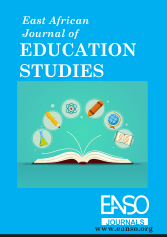The ‘Self’ of Hearing-Impaired Learners and their Transition from Primary to Post-Primary Education in Uganda
Abstract
In Uganda, post-primary education is one of the milestones in a child’s education. It is characterized by many challenges, particularly faced by learners with hearing impairments attempting to transition from primary to post-primary level. The transition has long been recognized as one of the most challenging issues for learners with hearing impairments, yet it has not been resolved by impeccable empirical scrutiny. This quagmire prompted the researcher to use a phenomenological investigation to explore the significant self-concepts affecting the learners’ transition from primary to post-primary studies. Interviews and group discussions with randomly selected learners who had joined and those who had failed to proceed to post-primary schools were involved. Also, corroborative views and opinions were obtained from preferred teachers and parents in interviews and discussions. It was discovered that the transition of learners with impaired hearing from primary to post-primary level was substantially influenced by family socioeconomic status, gender, age, health, and the learner’s cultural issues – validating the applicability of Schlossberg’s Theory of Transition to provide person-centered answers to transition deterrents, inhibiting the learners from joining and or staying in post-primary schools. It was recommended that self-advocacy training at the primary level be enhanced to help learners develop the skills they need for confidence growth in their abilities before, during and after the transition to post-primary educational institutions
Downloads
References
Ashton, J., & Ashton, D. (2019). Loss and grief recovery: Help caring for children with disabilities, chronic, or terminal illness. Routledge.
Barnett, L. A. (2014). Evaluation of relationship between self-advocacy skills and college freshman first-semester grade point average for students with disabilities. University of Montana.
Bloyce, J., & Frederickson, N. (2012). Intervening to improve the transfer to secondary school. Educational Psychology in Practice, 28(1), 1-18.
Bonanni, M. (2015). In transition: examining students with learning disabilities' transition from high school to college through Schlossberg's transition theory.
Burden, R. (2008). Is dyslexia necessarily associated with negative feelings of self‐worth? A review and implications for future research. Dyslexia, 14(3), 188-196.
Coccarelli, J. L. (2010). Applying Schlossberg's Transition Theory to students with learning disabilities in the transition from high school to college (Doctoral dissertation, University of Southern California).
Estrella, V., & Lundberg, C. A. (2006). Moving In, Moving Through, Moving Out. Nancy K. Schlossberg’s Transition Theory Victoria Estrella Carol A. Lundberg, PhD CSA 552: Process of Adult Development 27, January 2006 Research Paper: Student Development Theorist, 17
Evans, N. J., Forney, D. S., Guido, F. M., Patton, L. D., & Renn, K. A. (2009). Student development in college: Theory, research, and practice. John Wiley & Sons.
Galton, M., Morrison, I. & Pell, T. (1999). Transfer and transition in English schools: Reviewing the evidence. International Journal of Education, 33, 341–363.
Hintermair, et al (2018). Factors for professional success – What deaf education can learn from deaf and hard of hearing people who are successful in their career. The Volta Review, 117(1- 2), 32- 61. doi:10.17955/tvr.117.1.2.794
Luckner, J. L., & Sebald, A. M. (2013). Promoting self-determination of students who are deaf or hard of hearing. American Annals of the Deaf, 158(3), 377–386.
Macharia, J. M. (2018). Cultural and environmental factors affecting transition of learners with physical disabilities from primary to secondary schools in Laikipia County, Kenya. 144.
Marschark, M., Shaver, D. M., Nagle, K. M., & Newman, L. A. (2015). Predicting the academic achievement of deaf and hard-of-hearing students from individual, household, communication, and educational factors. Exceptional Children, 81(3), 350–369.
McIlroy, G., & Storbeck, C. (2011). Development of deaf identity: An ethnographic study. The Journal of Deaf Studies and Deaf Education, 16(4), 494-511.
Merriam, S. (1998). Adult life transitions: Opportunities for learning development. In Leahy, M., & Wolf, M. (Eds.), Adults in transition (pp. 9-18). Washington, DC: AAACE.
Milsom, A., & Hartley, M. (2005). Assisting students with learning disabilities transitioning to college: What school counselors should know. Professional School Counseling, 8(5), 436-441
Ntekane, A. (2018). Parental involvement in education. Research Gate, 1, 1-5.
Powers, M. S. (2010). Applying Schlossberg’s transition theory to nontraditional male drop-outs. Pro Quest Digital Dissertations.
Schlossberg, N. K. (2008). Overwhelmed: Coping with life's ups and downs (2nd ed.). Lanham, MD: Rowman & Littlefield Pub. Group.
Schmidt, O., & Mawenu, R. (2013). How do low-income parents pay school fees? A diary-based inquiry from Western Uganda. In European Microfinance Research Conference.
Stradling, R., & MacNeil, M. (2000). Moving on: The emotional well-being of young people in transition from primary to secondary school. Report published by Highland Health Board of Scotland, Inverness, UK.
Stone-MacDonald, A., & Butera, G. D. (2012). Cultural beliefs and attitudes about disability in East Africa. Review of Disability Studies: An International Journal, 8(1).
Tobbell, J. (2003). Students’ experiences of the transition from primary to secondary school. Educational and Child Psychology, 20(4), 4–14.
Troiano, P. F., Liefeld, J. A., & Trachtenberg, J. V. (2010). Academic support and college success for postsecondary students with learning disabilities. Journal of College Reading and Learning, 40(2), 35-44.
Van Ameringen, M., Mancini, C. & Farvolden, P. (2002). The impact of anxiety disorders on educational achievement. Journal of Anxiety Disorders, 17(5), 561–571.
Van Rens, M., Haelermans, C., Groot, W., & Maassen van den Brink, H. (2018). Facilitating a successful transition to secondary school:(how) does it work? A systematic literature review. Adolescent Research Review, 3, 43-56.
West, P., Sweeting, H., & Young, R. (2010). Transition matters: Pupils’ experiences of the primary-secondary school transition in the West of Scotland and consequences for wellbeing and attainment. Research Papers in Education, 25(1), 21–50.
Zeedyk, M. S., Gallacher, J., Henderson, M., Hope, G., Husband, B., & Lindsay, K. (2003). Negotiating the transition from primary to secondary school: Perceptions of pupils, parents and teachers. School Psychology International, 24(1), 67–79.
Copyright (c) 2024 Bonaventure Wasswa Ssebyanzi, Mary Kagoire Ocheng

This work is licensed under a Creative Commons Attribution 4.0 International License.




























